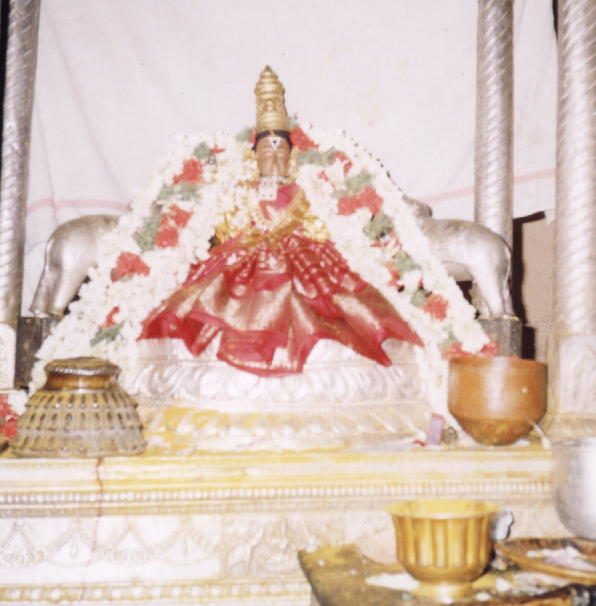
SRI PADMAVATHI THAYAR
Thirumangai Alwar appeared as the last of Alwars. But he holds an unique position. In the history of all other Alwars we do not find much of news about their marriage and efforts taken. But Thirumangai Alwar, loved a woman, proposed to her, acted according to her conditions to get her hand and finally got her married. He loved a girl and took all efforts to succeed in that love. Many damsels of Swarga lok, the Kingdom of Indra, used to come down to earth and play in select places and return to their place. One day some women of Indra lok arrived at Thiruvellakkulam. But one of them was so much attracted by the beauty, decided to stay back and live on earth. She was brought up by a local doctor. She was christened Thirumamagal [திருமாமகள்]. She grew up to an attractive girl, at the same time by daily worshiping the Lord, her spiritual mind also developed. Once she was plucking kumuda [ a sort of water lily] flowers. Because of her interest in those flowers, she got the name Kumudavalli. Thirumangai Alwar who was at that time in this place, happened to see Kumudavalli and he fell in love with her. He requested her and her father, the doctor, for marriage with him. While the doctor was unable to say no to the offer, Kumudavalli was not that easily yielding. She stipulated certain conditions for marriage, which the Alwar was ready to accept. She said that the Alwar should first come as a true Srivaishnava. That is he should undergo pancha samskaram [ five rituals]. For that one needs an Acharya and even today these rituals are very important among Vaishnava community. In Swami Ramanuja sampradhayam [tradition], person who has undergone pancha samskaram is certain to reach Vaikuntam. It is also considered as a marriage between us and the Lord. These rituals are:
- Thapa: [ताप:]- Using hot metal [usually silver] emblems of chakra [discus] and shankam [conch], impressions are made on the right and left shoulders, respectively.
- Pundra: [पुणड्र:] - decorting the body on forehead, arms, etc., with symbols of the feet of the Lord [popularly known as thiruman -srichoornam -திரு மண், ஸ்ரீ சூர்ணம் ]. These are to be drawn daily on 12 places on the body.
- Nama [नाम ] - A new name will be christened. Usually, a dasya nama [name indicating the servant or disciple of Lord or an Acharya - like Venkatesa dasa or Ramanuja dasa]. By this he joins the single community of servants of the Lord.
- Mantra [मंत्र:]- Important mantras Ashtaksharam [ also known as Thirumanthram], dwayam and charama sloka [from Gita] would be taught by the Acharya.
- Yaga [याग] - Performing daily pooja [திரு ஆராதனை ] will be taught.
aham kratur aham yajnah
svadhaham aham ausadham
mantro ’ham aham evajyam
aham agnir aham hutam
"But it is I who am the ritual, I the sacrifice, the offering to the ancestors, the healing herb, the transcendental chant. I am the butter and the fire and the offering."
He says He appears as all the various parts of a yagna. Though the list mentioned contains many, we should not forget that He, as One, appears in all. Aham = I, Sri Krishna, am, kratu = all the various yagnas performed to obtain swarga, etc., aham = I, Sri Krishna, am, yajna = activities like pancha maha yagna, one is expected to do daily [ brahma yagna, deva yagna, pithru yagna, manushya yagna and bhootha yagna], aham = I, Sri Krishna, am, svadha = offerings made to pithrus [deceased ancestors] for their welfare, aham = I, Sri Krishna, am, ausadam = havis or the sacred offerings made in sacred fire in yagna, aham = I, Sri Krishna, am, mantra = all the chanted mantras in an yagna, aham = I, Sri Krishna, am, eva = alone, ajyam = ghee offered in the sacred fire in yagna, aham = I, Sri Krishna, am, agni = the sacred fire itself, aham = I, Sri Krishna, am, hutam = the entire homa or yagna or yaga. In the yagna, He is the total yagna, the fire, ghee offered, the person performing, the mantras chanted, offered havis, and what not? He appears as all these separate entities and all these entities are in His control and are dependent on Him. What we see as separate are many and are the effects of the Single Cause, the Lord Sri Krishna. Bhakta sees all these as He alone. This He praises as Gyana yagna. We will now pray to the Lord and Sri Padmavati Thayar and take leave of Thiruvellakkulam.
No comments:
Post a Comment